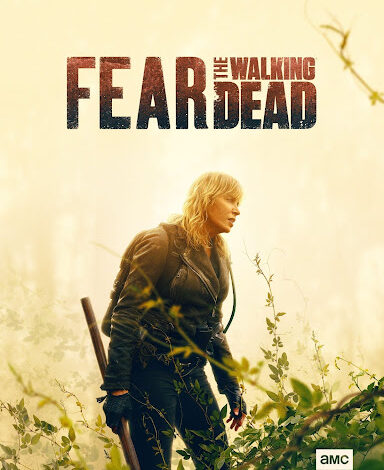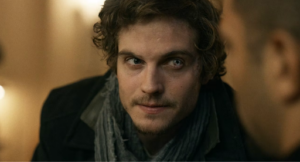Fear the Walking Dead Season 8B & Series Overview: How NOT to Write a TV Show
Spoilers ahead.

Charlie von Peterffy ‘24 / Emertainment Monthly Staff Writer
It is well known that, with age, most TV shows that survive cancellation beyond 3-5 seasons wither—for example, The Office post-Steve Carrell’s Michael Scott, though its age began showing much earlier. For TV to be compelling (or at least fun), viewers must be able to rally behind relatable characters, and the showrunners must translate an action-packed or evocative story. To be consistent and suggestive, overarching narratives, intriguing story beats, and character arcs/swings work best when they illustrate complex relationship dynamics and abstract ideas. TV, no matter the genre, should be bold, engaging, well-paced, and offer periodic climaxes to grip viewers into, well, viewing.
Fear the Walking Dead is none of that. Since 2018, it has steered clear of that as much as possible.
Once a promising spin-off that showed signs of becoming superior to its sister show The Walking Dead, Fear floated into shaky territory due to a showrunner change, an integral character’s death, and a character crossover in its fourth season. Changing the original plan––though always rocky––and doggedly moving further away from it ruined the show. The writing tanked; main characters got killed off and replaced with dull morality vacuums, only to magically reappear many seasons later; storylines became contradictory, meanderingly dry, and even downright stupid; characters, old and new, would make outrageous decisions and become increasingly annoying with time; every attempt at clever symbolism or metaphorical storytelling came to feel trite, and lazy. In order to understand how bad the show became and how cringeworthy its last, desperate cling to the original premise in season 8B plays out, it is essential to understand what exactly went wrong, at least from the perspective of a mega Walking Dead fan who has watched Fear from inception up to its ugly bow-out.

Fear the Walking Dead started in 2015 in Los Angeles, starring two dysfunctional families and a rich con man at the start of civilization’s fall in a zombie apocalypse. It also initially served as a prequel to The Walking Dead. There are the Clarks, with a high school student-counselor named Madison (Kim Dickens), her two kids Alicia (Alycia Debnam-Carey) and drug addict Nick (Frank Dillane), her history teacher fiancé Travis Manawa (Cliff Curtis), his son Chris (Lorenzo James Henrie) and ex-wife/Chris’s mother Liza Ortiz (Elizabeth Rodriguez). Then there are the Salazars, composed of the brutal, tortured war veteran-turned-barber, Daniel (Rubén Blades), his wife Griselda (Patricia Reyes Spíndola), and their daughter Ofelia (Mercedes Mason). Lastly, there’s Victor Strand (Colman Domingo), a con man with many tricks. After colliding with each other because of riots and weird outbursts of aggression from those previously thought dead (AKA apocalyptic beginnings), the group embarks on a dangerous journey through suburban and central LA. They experience military occupation, near-death experiences, the throes of familial trauma and drug addiction, and an overwhelming amount of death and destruction. While it had flaws-filler dialogue, flat subplots, bloated scripts, and a few stiff actors—it was intense, somewhat thematic, dramatic, and fresh because of the West Coast setting and new characters.
The show begins to stumble quickly and only worsens in its sophomore season. Though Nick and Alicia shape into compelling co-leads, and seeing the apocalypse from a yacht at sea is unique, the show trudges through many disjointed subplots. It also uses many two-dimensional characters played unconvincingly to fill episodes. Playing the central lead, Madison Clark, actress Kim Dickens is consistently nonreactive to her environments even for the psychopath she was meant to portray, and too many other compelling characters are killed off. In its third season, however, Fear finally showed promise.
At 16 episodes, there isn’t one of Fear Season 3 that feels unnecessary or distractedly hollow. In the primary storyline, Madison’s family is moved to a ranch run by the Otto family in San Diego, California, after they all get captured at the U.S.-Mexico border by the ranch owner’s sadistic military-trained son, Troy (Daniel Sharman). Troy wants to use them for zombie experiments and injects the show with maniacal intensity Fear eventually becomes known for. On the trip, Madison’s husband Travis is shot dead, but the rest make it and mourn. Troy’s brother, Jake (Sam Underwood), and father/ranch owner Jeremiah (Dayton Callie) discover Troy’s misdeeds and quickly welcomes Madison and her kids into the community. While there, Nick grows dangerously close to Troy, who mirrors much of Nick’s self-destructive tendencies—“You share the same self-destruction,” Alicia explains to Nick in a confrontation. They learn that Travis’s killer is Qaletaqa “Taqa” Walker (Michael Greyeyes), the leader of the Indigenous American Black Hat Reservation who is at war with the Ottos because of their claim over reservation lands. Madison and her family must navigate new dynamics within the community, settle the land dispute, and survive.
Meanwhile, Victor Strand is held prisoner at a hotel in Tijuana, Mexico. Daniel, presumed dead after lighting a basement on fire during a hallucination in season 2, shows up and strikes a deal: to be free, Strand must find Daniel’s daughter, Ofelia, and also solve a local water shortage. The two go to the Gonzalez Dam, a community that controls water flow to all survivors within the area through an actual dam. As Strand knows the dam operations leader, Daniel hopes Strand can convince them to let water flow.
As this is the best season, no other spoilers about how it unfolds or ends, except that Madison eventually bashes Troy Otto’s head with a hammer, killing him (or so we think!).
Point being is that the series reached its highest point in its third outing because of an ever-moving, unpredictable, and gruesome story, a grounded group of intriguingly dysfunctional people, and compelling themes about morals in the face of survival. Though Madison is annoyingly wooden, she becomes darker now that the focus is on her two kids. Nick, though past his addiction, becomes increasingly self-destructive, but socially aware, creating an exciting contradiction in his reasoning and moral compass. Alicia becomes the sole beacon of hope, leading people to what she believes best––even if they die because of it.
Nick Clark, especially, shapes vaguely into the central lead he was always meant to become. Dillane portrays Nick as a highly fractured, broken kid who finally finds strength in the apocalypse. He is in the first shot of the show, and his girlfriend, whom Nick finds turned minutes after the opening, is canonically patient zero of The Walking Dead Universe’s apocalypse. His addiction and self-destruction shaped a lot of the events of the early seasons; his addiction and later withdrawals harshly affected everyone in his family, and unhealthy impulses led to disastrous results. Dillane portrays these defective traits masterfully, making Nick one of the defining draws of the show.

The series, even in season 3, did have many flaws. For example, Strand and Salazar aren’t handled nearly as well as the Clark trio, with the dam subplot and Daniel’s storyline in particular feeling disjointed and rushed. But overall, season 3 is Fear at its grittiest and densest.
Then, season 4 happens. Star Trek Discovery writers Ian Goldberg and Andrew Chambliss replace original showrunner Dave Erickson. The show jumps forward two years to be in the same timeline as Walking Dead. Morgan Jones (Lennie James) from the mothership show is brought over, bringing his previously tiresome morality to Fear (though James’s acting remained phenomenal until the end). Nick is killed unexpectedly three episodes in mid-arc, and his stiff, kid-aged killer, Charlie, is left alive as a replacement. Madison is presumed dead after bringing a horde of zombies into (instead of away from?) a stadium where she and her kids previously lived (or so we think!). The story moves to Texas. We never learn the aftermath of the dam or how anyone survived. The old cast and ideas of the show get tossed, replacing Daniel and the Clarks-minus-Alicia with a cowboy named John Dorie, a nurse named June, a journalist named Al, and Morgan. Season 4 was a soft reboot of Fear with almost all new characters, a new location, and a flat storyline, mostly separate from the first three seasons.
The show from here on essentially becomes a self parody of varying levels. Both seasons 5 and 7 are considered amongst the fanbase the worst of the series, and there are numerous reasons as to why. Take just the storyline of the 5th season’s first eight episodes: Morgan, Alicia, Strand and co. crash a plane in the middle of Texas (with no explanation of how it’s found or how they can fly it) because they heard a random distress call for help. Upon arrival they discover they’ve been set up in an elaborate trap in a wasteland of irradiated zombies. There’s also a random group of kids nearby.
Instead of avoiding these conflicts or at least intelligently facing them, as Morgan declares boldly in every other sentence, because “all life is precious” they must forfeit all thought and charge ahead in the name of life. They magically find a warehouse and build a plane with the group of kids after one of them reads The Little Prince’s similarly fantastical plane rebuild. Nick Clark’s killer Charlie and now altruistically preachy Strand save the day in a beer bottle-shaped blimp. Daniel Salazar, whose disappearance in season 4 went unexplained, comes back into the fray with a thinly veiled altruism completely different from the tortured persona in seasons 1-3. Instead of torturing people, he now goes soft on Charlie (again, the killer of the face of Fear’s original story Nick Clark) and teaches her how to play ukulele. This inorganic narrative, paired with canned writing––“I wouldn’t be who I am today if it weren’t for you people, so I’m gonna stay and fight” Dwight yells hollowly to motivate his group to take another group from the dead after supposedly changing his ways for the sake of Morgan’s moral mission––made Fear plainly dull by this point.

Season 6 is a surprise, as the extended brainstorm during the COVID-19 lockdown allowed Chambliss and Goldberg to make at least three-quarters of a season’s worth of binge-worthy, high-stakes TV about the threat of nuclear fallout in the apocalypse. Morgan became the best version of himself across any show he’s been in. All characters, pre- and post-reboot Fear, had a purpose and great moments. But after that, as explained, the series became duller and progressively more offensive in its flaccid writing and contrived story beats. Most of the good characters, such as the last Clark, Alicia, eventually leave as well, as the show’s budget and viewership in real time got progressively lower.
Season 8B, the last half of this slop fest’s final season, attempts to bring the show full circle with tragically cartoonish results. This half-season follows original Fear protagonist Madison Clark (Kim Dickens) as she tries to save a community she now leads called PADRE against an old nemesis. Troy Otto, the man Madison thought she killed at the dam in Mexico back in season 3, is alive despite blindness in the eye near where she hit and on a quest for vengeance against Madison. In the woods now deep in Georgia, original The Walking Dead’s home state, Madison, Strand, Daniel, and additional co-stars Luciana (Danay Garcia), Dwight (Austin Amelio), Sherry (Christine Evangelista), June Dorie (Jenna Elfman) and Troy’s new daughter Tracy (Emma Caulfield Ford) must stop Troy at any cost before he destroys PADRE and everything they built.

The showrunners finally attempt to bring the original storylines back into the fold. After Morgan departs the show in 8A’s midseason finale, Madison is again the series lead, surrounded by mostly the original cast. Troy’s incredibly brief reintroduction rehashes a lot of pre-season 4 Fear’s ideas and storylines previously abandoned. This focus on the show’s original premise and cast slightly reenergizes it with more proper continuation after years-long filler. But it does not escape the consistently poor writing and bad decisions that have plagued the show for years on top of the obvious budgetary constraints and seeming lack of interest the cast now has in their roles. They push the envelope in all the wrong logistical ways, killing bad characters off offensively and the good ones with potential in wasteful ways, and portraying antagonists in a blatantly racist fashion.
The story, though decent in concept, unfolds disastrously on screen. Troy and Madison’s dual returns as central players in Fear add some kinetic energy, but they make outrageous decisions and do blatantly dumb things that get themselves and their loved ones in further danger. Most of what occurs is also exposition to fill in historical gaps, such as Troy’s unseen altercation with Alicia Clark after season 7, how his wife died because of her, and much more. It is dull and outrageous, as these moments sound much more scintillating than the present narrative (and a cop out explaining why it took over three seasons to get back on the original track).
Walkie talkies also magically have unlimited power and range, so people contact each other wherever they are but at the same time fail to accidentally find others. For example, Luciana returns as the new leader of a truck-stop outpost reminiscent of the season 4 and 5 do-good-no-matter-what storyline, and it’s established she’s set up a large network. Why did no one accidentally pick up a single message of her’s or the group’s over the walkie talkie? Because the writers didn’t want her revealed until later, seemingly.
The cast, especially now, feels disinterested in their characters. Colman Domingo, once a strong point in Fear’s silliest moments and a superb performer in his own right, portrays Victor Strand with laughable embarrassment. When he protests as he has many times over Fear’s post-reboot run that “I tried” to be better, he seems insincere and almost embarrassed––as an actor, not as a character. Dickens is as wooden as before, Garcia continues her hammy attempt, Amelio and Evangelista act bored whenever on screen, and none of the newest additions help. Blades as Daniel is about the only returning appearance to still put the effort in, as his scenes are intense in spite of the many one-liners. Sharman as Troy is also cunningly evil, as he brings the exact unpredictable intellect to the evil that made him famous in the first place. Chemistry between original Fear characters is also pleasant regardless of acting abilities and Morgan’s absence is welcome, which makes things more palatable. But mostly, no one seems present any longer.
The sets are also visibly staged. While the show post-season 3 has been visually wonky—a cliché black-and-white lens filled season 4 and a urine-colored yellow lens in season 7—the physical sets themselves have consistently been one of the better aspects of the show. Unfortunately, due to the (understandable) minuscule budget, even the sets now look half-baked. Stone walls and iron fences look like spray painted cardboard; boats freshly store bought; rooms barely scuffed or stylized. The cinematography of this season is refreshing as they use many more revolving shots, and the costumes are still decent, but beyond that the budget shows.
Lastly, and perhaps most offensively, the show presents most side antagonists very racistly and kills off Charlie via suicide with no warning. Most of the side villains, such as returning soldiers from PADRE’s original runners in the first half of the season, are wrapped in head cloth reminiscent of a Middle Eastern headdress such as a keffiyeh. Conversely, the protagonists are dressed in amateur military gear and more Western accepted clothing. To make the villains look like a stereotypical terrorist further degrades these cultures and peoples. Additionally, after Madison discovers Charlie killed her son Nick back in season 4, she sends Charlie on a mission to infiltrate Troy’s HQ. After getting captured and faced with a trade, Charlie decided the best course of action is to shoot herself in the head. While intended to push the narrative and drive Madison to understand why “everyone deserves a second chance,” it is just an unnatural, random, and shocking death that should’ve been entirely avoided.
Overall, the last chunk of Fear the Walking Dead is as disastrously lackluster as the last several seasons of the original show. It is good to finally let Fear’s grotesque corpse lay to rest. The entire show is an intriguing watch for TV study purposes, as one can learn through its course how a show can easily go from being nearly great to oh-so terrible.